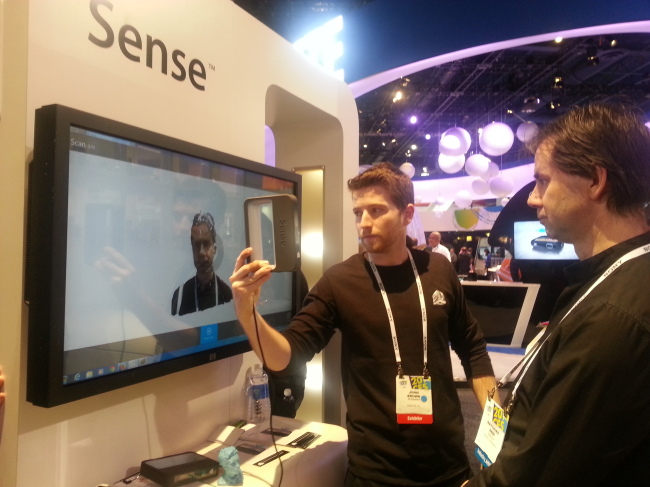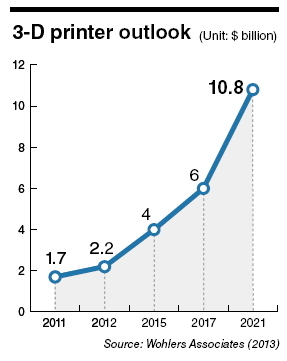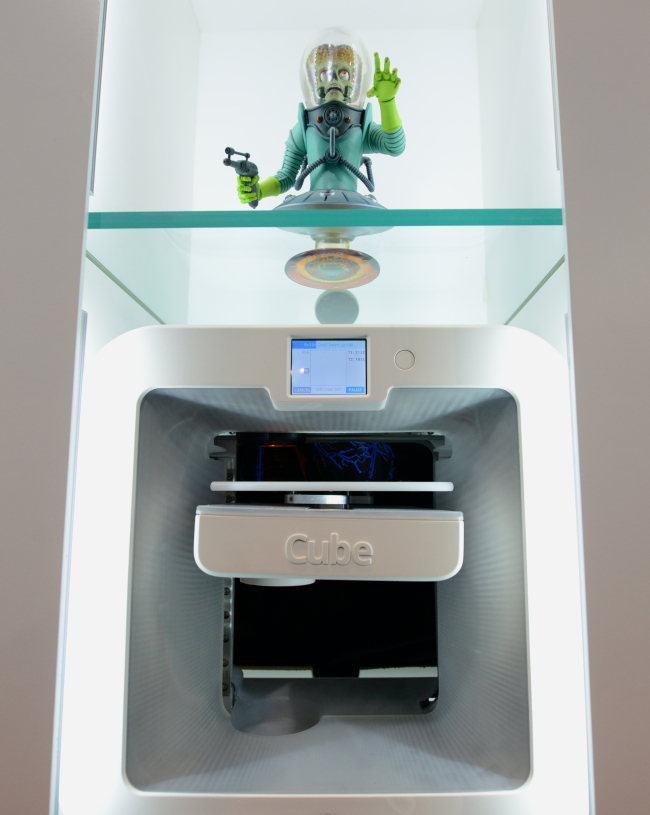3-D printer firms eye global rush
Leading players set for further expansion in Korea
By Park Hyung-kiPublished : Jan. 15, 2014 - 19:45

Global 3-D printer makers are gearing up to expand in Korea this year to boost their services for manufacturing giants such as Samsung Electronics and Hyundai Motor and tap potential customers.
3-D Systems, founded in 1986, is one of the global leading printer makers seeking growth in Asia’s fourth-largest economy, where Samsung and Hyundai Motor have been its key tech customers.

“We intend to grow our base there,” Cathy Lewis, chief marketing officer of 3-D Systems, told The Korea Herald during the 2014 International CES last week.
“Those Korean companies are extremely important for us as they taught us a lot about what their needs are, (and) they help us to develop new materials and solutions.”
3-D printing is used for prototyping and designing products such as smartphones and automobiles.
“Any physical product that you are holding in your hands, driving, flying or wearing has been using the printers for some time,” the CMO said.
“The only challenge might be just making sure that we continue to find amazing and compelling content for consumers.”
The printer maker, whose global customers include Apple, GM and GE, unveiled a series of new models including the Cube 3, CubePro and ChefJet during the electronics show.
“Those Korean companies are extremely important for us as they taught us a lot about what their needs are, (and) they help us to develop new materials and solutions.”
3-D printing is used for prototyping and designing products such as smartphones and automobiles.
“Any physical product that you are holding in your hands, driving, flying or wearing has been using the printers for some time,” the CMO said.
“The only challenge might be just making sure that we continue to find amazing and compelling content for consumers.”
The printer maker, whose global customers include Apple, GM and GE, unveiled a series of new models including the Cube 3, CubePro and ChefJet during the electronics show.

The Cube 3, for instance, enables users to print objects in 22 colors with the most common filaments including acrylonitrile butadiene styrene and polylactic acid.
ChefJet users can create edible prints such as confections and cake toppers.
3-D Systems also introduced Sense, a handheld scanner that scans an object and produces 3-D printable computer images, and the 3DMe Photobooth, which captures the face of a user and places the captured image together with an image of any host of celebrities.
Jonathan Cobb, executive vice president of corporate marketing at Stratasys, also made a bright business forecast as he expected the 3-D printer firm to grow more than 35 percent this year.
“We were selling one or two machines at the beginning, and today with the acquisition of MakerBot, we are selling tens of thousands of machines every single year,” Jonathan Cobb said.
Stratasys, established in 1989, acquired desktop 3-D printing firm MakerBot in a stock deal worth $403 million last year.
He said the company would continuously strengthen business relations with Korean firms, which are critical partners for the U.S. printing company.
“We have increased our presence in Korea by expanding our distribution in the nation, and opening a brand new office there about two weeks ago,” Cobb said.
While focusing on beefing up its competitive edge in price and print speed, Jonathan Cobb said the company would try harder to entice corporate customers in design, engineering and manufacturing sectors.
“Stratasys would make efforts to meet the needs of such industrial customers by coming up with materials they want,” he said.
It is only a matter of time for users to be able to manufacture a whole product at once without going through different assembly processes as more filaments and advanced printers are being developed, according to the executive vice president.
Multi-material 3-D printing technology is already available for some of its printer models.
He also said Stratasys, which has been working with the National Aeronautics Space Administration for several years to utilize 3-D printers in space shuttles, will probably send a printer to space to produce shuttle and space station parts next year.
Startups participating at the electronics trade show were not short of innovation, such as WoobleWorks’ 3Dooler, which has received much media attention since its debut last year.
“We have a lot of plans including new accessory lines such as a pen holder to increase precision of drawing, and next year we will have a lot more different sizes of pens including a kid version and a pro version of the 3Doodler,” said Maxwell Bogue, cofounder and CEO of WoobleWorks, at his firm’s booth at the CES.
The printing pen has recently started hitting retail stores in the U.S. such as Brookstone and ThinkGeek, and will soon be shipped to Korea.
“We have Korean distributors with which the company recently inked a contract, and we are very excited about the Korean industries,” the CEO said.
By Kim Young-won (wone0102@heraldcorp.com)
ChefJet users can create edible prints such as confections and cake toppers.
3-D Systems also introduced Sense, a handheld scanner that scans an object and produces 3-D printable computer images, and the 3DMe Photobooth, which captures the face of a user and places the captured image together with an image of any host of celebrities.
Jonathan Cobb, executive vice president of corporate marketing at Stratasys, also made a bright business forecast as he expected the 3-D printer firm to grow more than 35 percent this year.
“We were selling one or two machines at the beginning, and today with the acquisition of MakerBot, we are selling tens of thousands of machines every single year,” Jonathan Cobb said.
Stratasys, established in 1989, acquired desktop 3-D printing firm MakerBot in a stock deal worth $403 million last year.
He said the company would continuously strengthen business relations with Korean firms, which are critical partners for the U.S. printing company.
“We have increased our presence in Korea by expanding our distribution in the nation, and opening a brand new office there about two weeks ago,” Cobb said.
While focusing on beefing up its competitive edge in price and print speed, Jonathan Cobb said the company would try harder to entice corporate customers in design, engineering and manufacturing sectors.
“Stratasys would make efforts to meet the needs of such industrial customers by coming up with materials they want,” he said.
It is only a matter of time for users to be able to manufacture a whole product at once without going through different assembly processes as more filaments and advanced printers are being developed, according to the executive vice president.
Multi-material 3-D printing technology is already available for some of its printer models.
He also said Stratasys, which has been working with the National Aeronautics Space Administration for several years to utilize 3-D printers in space shuttles, will probably send a printer to space to produce shuttle and space station parts next year.
Startups participating at the electronics trade show were not short of innovation, such as WoobleWorks’ 3Dooler, which has received much media attention since its debut last year.
“We have a lot of plans including new accessory lines such as a pen holder to increase precision of drawing, and next year we will have a lot more different sizes of pens including a kid version and a pro version of the 3Doodler,” said Maxwell Bogue, cofounder and CEO of WoobleWorks, at his firm’s booth at the CES.
The printing pen has recently started hitting retail stores in the U.S. such as Brookstone and ThinkGeek, and will soon be shipped to Korea.
“We have Korean distributors with which the company recently inked a contract, and we are very excited about the Korean industries,” the CEO said.
By Kim Young-won (wone0102@heraldcorp.com)



![[Exclusive] Korean military set to ban iPhones over 'security' concerns](http://res.heraldm.com/phpwas/restmb_idxmake.php?idx=644&simg=/content/image/2024/04/23/20240423050599_0.jpg&u=20240423183955)

![[Graphic News] 77% of young Koreans still financially dependent](http://res.heraldm.com/phpwas/restmb_idxmake.php?idx=644&simg=/content/image/2024/04/22/20240422050762_0.gif&u=)



![[Pressure points] Leggings in public: Fashion statement or social faux pas?](http://res.heraldm.com/phpwas/restmb_idxmake.php?idx=644&simg=/content/image/2024/04/23/20240423050669_0.jpg&u=)









